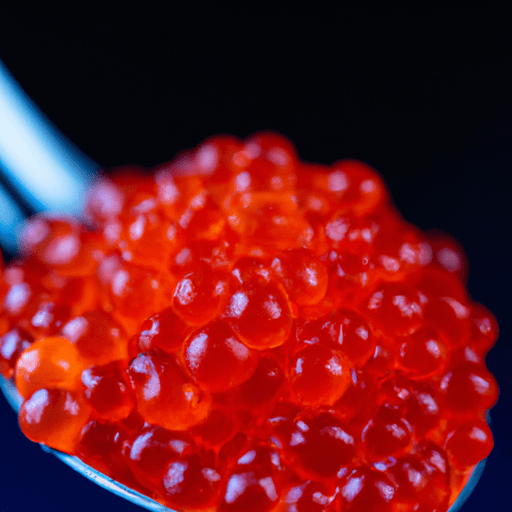The Gourmet Delight: Caviar Alternatives
Few delicacies can match the luxurious allure of caviar. With its delicate taste and striking appearance, this delicacy has graced the tables of royalty and connoisseurs for centuries. However, due to its rarity and high price tag, caviar may not be accessible to everyone. But fear not! Today, we will explore some exceptional alternatives that will grant you a taste of indulgence without breaking the bank or harming marine life. Let’s dive into the world of caviar alternatives!
The World of Caviar Flavors
Caviar, most commonly sourced from sturgeon, boasts a unique flavor profile that combines a subtle saltiness with a buttery richness. Fortunately, the realm of caviar alternatives is teeming with options, each offering its own distinct flavor and texture experience. Here are a few noteworthy alternatives:
Salmon Roe
Salmon roe, also known as red caviar, is among the most popular caviar alternatives available. Derived from the bright orange eggs of salmon, it delivers a flavor that delights the palate with a burst of saltiness, a hint of oceanic essence, and a mild nuttiness. These vibrant pearls make an excellent garnish for sushi, canapés, or a classic blini topped with crème fraîche.
Lumpfish Roe
Lumpfish roe, with its glistening black eggs, is another fantastic substitute for caviar. With a pronounced salty and tangy taste, it provides a bold and briny experience. Its vivid colors make for an eye-catching addition to hors d’oeuvres or deviled eggs. The affordable price tag is an added bonus, enabling you to bring a touch of elegance to any occasion without breaking the bank.
Tobiko
Tobiko, originating from flying fish, is a favorite in Japanese cuisine. These petite, crunchy, and colorful pearls burst with a mild saltiness and a subtle smoky taste. Tobiko’s delicate texture and vibrant hues elevate sushi rolls, seafood dishes, and even salads. The satisfying “pop” that accompanies each bite adds an extra layer of enjoyment to your culinary journey.
Vegan Caviar
Embracing a plant-based lifestyle no longer means missing out on the joy of caviar. With recent advancements in culinary creativity, various vegan caviar alternatives have emerged, offering an array of exciting flavors and textures. Using ingredients like seaweed, algae, or tapioca pearls, vegan caviar can deliver a mesmerizing “occean” taste while being environmentally friendly and free from ethical concerns.
Nutritional Treasures
Beyond their enticing flavors and appearances, caviar alternatives also offer impressive nutritional profiles. They are excellent sources of high-quality protein, healthy fats, and essential vitamins and minerals. These delicacies are packed with omega-3 fatty acids, which promote heart health, boost brain function, and reduce inflammation. They also provide a rich source of vitamin B12, selenium, and iron, contributing to overall well-being.
A Historical Perspective
Caviar has a rich history intertwined with opulence and prestige. The tradition of consuming fish roe dates back centuries and was initially reserved for the elite. However, with the discovery of alternative sources and the desire for sustainable options, caviar alternatives have become more accessible to the general public.
In recent years, chefs and culinary enthusiasts have embraced the diversity and creativity that caviar alternatives offer. Their versatility in various cuisines has led to innovative uses beyond the traditional settings, enriching the culinary landscape. This newfound appreciation and exploration have allowed individuals to savor the luxury of the caviar experience without limitations.
So, whether you seek to impress guests with an elegant appetizer or elevate your own dining experience, caviar alternatives are delightful options that deserve a place in your culinary repertoire.
Take a dive into these affordable delicacies that mimic the opulence of traditional caviar. Explore their unique flavors, experiment with creative pairings, and let the allure of these tiny, glistening orbs transport you into a world of luxury and indulgence.
Caviar Alternative
Origin: Caviar alternative, also known as vegan caviar or faux caviar, is a plant-based substitute for traditional caviar, which is made from fish roe. The exact origin of caviar alternative is unclear, but it has gained popularity in recent years as a more sustainable and cruelty-free option.
Common Uses: Caviar alternative can be used as a substitute in a variety of dishes, much like traditional caviar. It is often served as a garnish or topping for appetizers, sushi rolls, salads, and canapés. It can also be mixed into sauces, spreads, or dips to add a burst of flavor and texture.
Nutritional Benefits: Caviar alternative typically does not share the same nutritional profile as traditional caviar, which is rich in omega-3 fatty acids and minerals. However, some vegan caviar alternatives may be fortified with nutrients like vitamin B12 and omega-3 fatty acids, providing similar benefits as the original. The exact nutritional content may vary depending on the specific ingredients used in the alternative.
Unique Properties or Historical Significance: Caviar alternative offers a cruelty-free and sustainable option for those who choose to avoid eating animal products. It is made using various plant-based ingredients, such as seaweed, tapioca, or vegetable oils, to mimic the appearance and texture of traditional caviar. While it may not have the same historical significance as traditional caviar, its rise in popularity reflects the growing demand for plant-based alternatives in the culinary world.




Use the share button below if you liked it.
It makes me smile, when I see it.